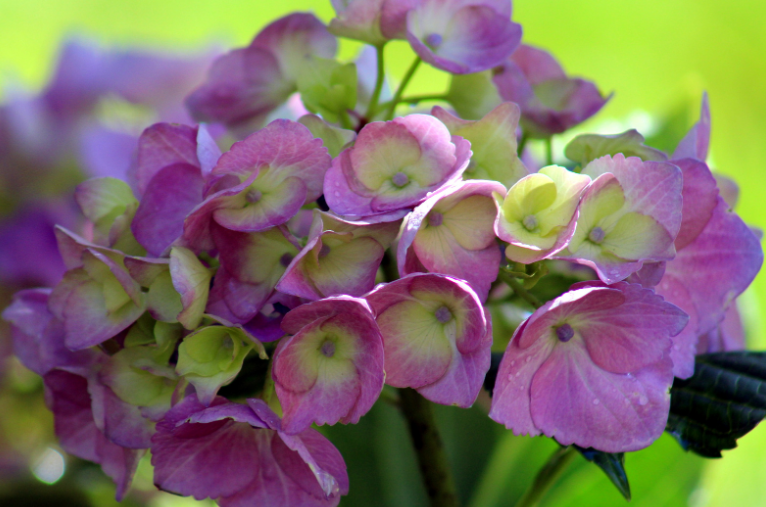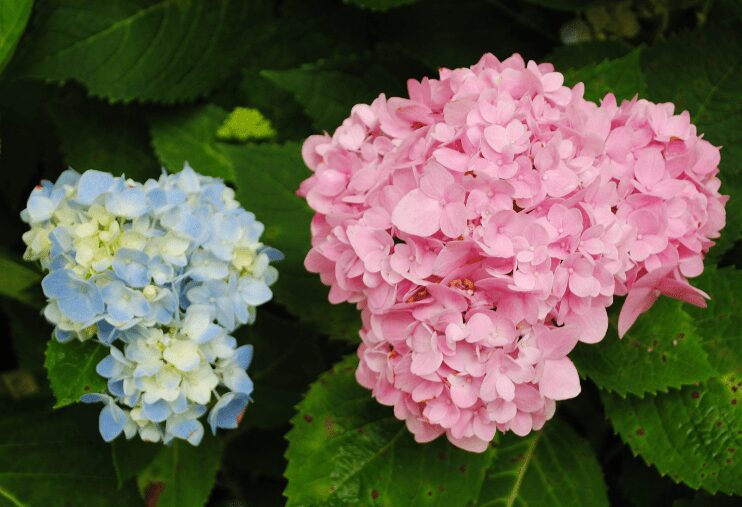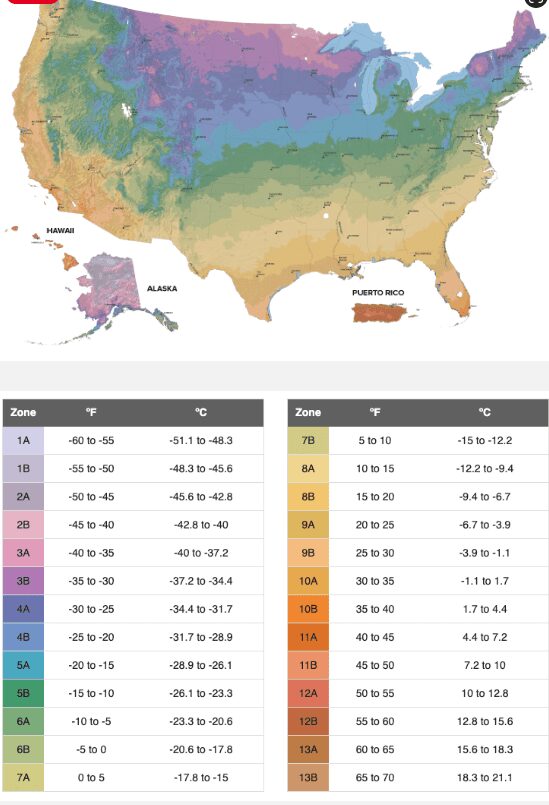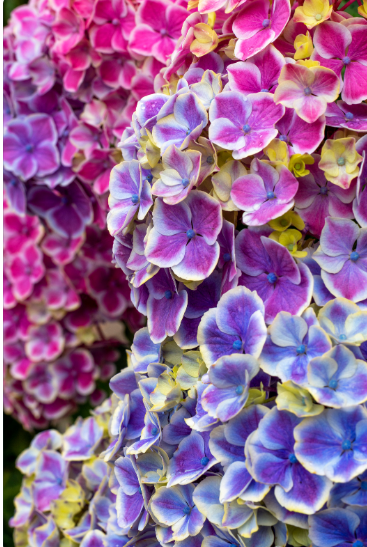
Several resilient reblooming hydrangeas go by the name Endless Summer Hydrangeas®. Their magnificent blossoms come in various hues, including pink flowers, blue, purple, red, and white.
Pink blooms develop in alkaline soil, so certain amendments need to be made to lower the pH and create an acidic situation. We suggest Color Me Blue soil sulfur to encourage blue bloom production. This is safe, organic and all-natural
This mophead hydrangea (Hydrangea macrophylla) plant blooms on stems from the previous year and the current season, which is not how mophead hydrangeas typically bloom. The Endless Summer hydrangea bloom habit produces flowers from early spring through late summer.
It is the ideal flowering hydrangea shrub for foundation plantings, pots, perennial flower borders, and anywhere you desire colorful blossoms in your garden. It has a rounded growth habit and dense, widely ovate green leaves.
Hydrangeas are toxic to humans, dogs, cats, and horses.
Endless Summer Hydrangeas – A Gardener’s Delight
Light
Endless Summer Hydrangeas prefer full sun but can tolerate partial afternoon shade. They also like to be watered regularly and, during the spring, should be given an extra water boost before their roots begin to grow in earnest.
If they are planted in full sun, it may be too hot and intense for the blooms to produce. You can also inhibit bloom production by overwatering and overfertilizing your plants.
Watering & Fertilizing
When it’s hot and dry, let your hydrangea plant sit for a few days after you’ve watered it. Then give it another good soaking with a strong water hose on a sunny day.
Follow this watering by adding a fertilizer such as 10-10-10 or 5-5-5 at half strength during the growing season. At other times of the year, apply one cup of slow-release granular fertilizer every two weeks (1/2 strength).
Soil Preparation
Other than climate, soil is the most critical aspect of plants that grow naturally. Ensuring your soil is prepared correctly is crucial to the health and success of your plants.
Identifying your soil type is the first step. Get a soil test kit from your local nursery. “Jar Test” is another home test you can perform. Dig down 4″ and remove 14.5 cups of soil.
Place that soil, 2 cups of water, and a couple of drops of dishwashing detergent in a clear jar or plastic bottle.
Allow the contents of the jar to settle for approximately 24 hours after shaking for one minute.
There are three layers of sediment to settle out: sand, silt, and clay (which may look like yellow-brown, red, or tan water).
Most Hydrangea macrophylla only bloom on growth from the previous year; they don’t produce blooms on new growth, so they don’t flower nearly as long or as heavily as Endless Summer.
- Sand: If your jar contains over half sand, you have sandy soil.
- Silt: When there is little clay and more than half silt, you have heavy silt.
- Clay: Soil that contains 1/4 clay and significant amounts of silt is clay soil.
- Loam: Loam comprises 2/5 sand, 2/5 silt, and a thin clay layer.
Once you’ve determined your soil, hydrangea macrophylla can be planted more effectively.
The ideal soil type for Endless Summer hydrangea plants is loam. If you have heavy clay soil, add gypsum to drain and break up the clay.
The general rule is to apply 5 – 15 pounds of gypsum per 100 square feet.
Adding peat moss to sandy soil can increase the moisture absorption rate. In addition, humus and organic matter should be present at a minimum of 5 percent in good soil.
Generally, hydrangeas grow best when the organic material is spread 2 – 6 inches deep across the entire bed. In clay soils, organic matter creates air pockets that greatly improve water drainage.
Types of Endless Summer Hydrangeas

The ‘Original Bigleaf Hydrangea’ was the first reblooming hydrangea discovered, and it remains the most widely known and popular cultivar in the Endless Summer collection.
- There are three to five feet of blooms on this variety of Hydrangea macrophylla ‘Original Bigleaf Hydrangea’.
- With deep pink flowers or periwinkle blue blooms, Hydrangea macrophylla ‘Twist-n-Shout®’ grows three to five feet tall and wide.
- ‘Summer Crush®’ Hydrangea macrophylla: This compact variety grows 18 to 36 inches tall and wide and has raspberry red or neon purple blooms.
- ‘BloomStruck®’ Hydrangea macrophylla: This variety grows up to six feet tall and wide with vibrant rose-pink, blue, or purple blooms.
The only Endless Summer variety whose bloom color is not affected by soil pH is this three to four-foot variety with pure white blossoms that mature to blush pink or Carolina blue.

One of the fascinating aspects of Endless Summer hydrangeas is the ability to influence their bloom color. Here’s how to achieve a touch of magic in your garden:
- The Science of Color: The flower color of Endless Summer hydrangeas is determined by the soil’s pH level. Acidic soil (pH 6.0-6.5) promotes blue blooms, while alkaline soil (pH 7.0 and above) encourages pink blooms.
- Testing and Planning: Before making adjustments, it’s crucial to test your soil’s pH using a test kit from your local nursery. Knowing your starting point will help you determine the necessary steps.
- Shifting to Blue: If you desire blue blooms and your soil is alkaline, you’ll need to gradually acidify it. Apply aluminum sulfate (alum) according to package instructions, following up with a soil test after a few months to monitor progress. Remember, changing soil pH takes time, so patience is key.
- Maintaining Blue Blooms: Once you achieve blue blooms, maintaining slightly acidic soil is essential. Use fertilizers formulated for acid-loving plants and consider adding organic matter like coffee grounds or pine needles around the base of the plant to help retain acidity.
Pruning Endless Summer hydrangea
Endless Summer hydrangeas require minimal pruning. Never prune them in the fall.
The spring or early summer is the best time to prune without removing flower buds. Wait until green leafy growth appears on the stems before pruning.
Leave the green buds on the lower stems, as these will be the first to bloom after you remove the dried-out brown buds higher up the stem.
In the summer, blooms will emerge from the new stem growth at the plant’s base.
Endless Summer hydrangeas Growing Zones
Hardiness Map

The color area indicates growing zones where it thrives. Knowing this helps you pick the most compatible plant with your area. What does hydrangea do that bloom continuously throughout the year?
Reblooming hydrangeas bloom in late spring or early summer, like many “Hyperangea macrophylli” and then bloom once more produce blooms two times later in seasons.
Early Season flowering is produced by buds formed in the previous year. Flowers appear during summer form after the current season of growth.
Planting Endless Summer Hydrangeas
Endless Summer hydrangeas are known for their impressive blooms, but to achieve this vibrancy, you need to start with the perfect spot in your garden. Here’s what to consider when selecting a location:
- Light: Endless Summer hydrangeas thrive in a balance of sun and shade. Aim for 4-6 hours of morning sun with afternoon dappled shade. Too much direct sun can scorch the blooms, while full shade can limit flowering.
- Space: Consider the mature size of the variety you choose. Most Endless Summer hydrangeas grow 3-5 feet tall and wide. Space them 4 feet apart for individual plantings or 8 feet apart for larger groupings or foundation plantings.
- Shelter: Protect your hydrangeas from strong winds that can damage the blooms. Planting near a wall or fence can provide some wind protection.
- Accessibility: Choose a location where you can easily access the plant for watering, pruning, and admiring its beauty!
Soil Preparation for Vibrant Blooms
Endless Summer hydrangeas prefer moist, well-drained loam for optimal growth and vibrant blooms. Here’s how to prepare the soil for planting success:
- Soil Test: Knowing your soil’s pH level is crucial. Endless Summer hydrangeas prefer slightly acidic soil (pH 6.0-6.5). Purchase a soil test kit from your local nursery or garden center to determine your soil’s pH.
- Amendments for Loam: If your soil is already loam, you may only need to add some organic matter like compost or aged manure to improve drainage and provide nutrients. Aim for a 2-inch layer of organic matter incorporated into the top 12 inches of soil.
- Clay Soil Adjustments: If your soil is heavy clay, it will retain too much moisture. Amend it with gypsum or composted wood chips to improve drainage. Aim for a ratio of 50% existing clay to 50% amendments.
- Sandy Soil Enhancements: Sandy soil drains too quickly, depriving the plant of moisture. Amend sandy soil with organic matter like peat moss or composted leaves to increase moisture retention. Aim for a ratio of 70% existing sand to 30% amendments.
- Planting Time: The ideal planting time for Endless Summer hydrangeas depends on your climate. In warmer zones (7-10), plant in early fall to allow the roots to establish before winter. In colder zones (4-6), plant in early spring after the danger of frost has passed.
The original Endless Summer Hydrangeas Spacing
The borders should be planted 4 feet apart, and the center should be central. For a massive planting or a base plant, place plants 8 feet apart. This hydrangea is suitable for plants on plants for the garden. Make sure the plant has a minimum height of 30 inches. Hydrangeas need much higher moisture as pots dry easier than soil.
Caring for Your Endless Summer Hydrangeas: A Year-Round Guide
Watering Needs Throughout the Seasons
Endless Summer hydrangeas are thirsty plants, especially during hot weather. Here’s a breakdown of their watering needs throughout the year:
- Spring: As the weather warms and new growth appears, water your hydrangeas regularly. Aim to keep the soil consistently moist, but not soggy. A good rule of thumb is to water deeply when the top inch of soil feels dry to the touch.
- Summer: During the hot summer months, frequent watering is essential to prevent wilting and stunted blooms. Water deeply 2-3 times per week, or more often in periods of extreme heat or drought.
- Fall: As the temperatures cool and the plant goes dormant, you can reduce watering frequency. However, don’t let the soil completely dry out. Water deeply once a week or so, depending on rainfall.
- Winter: In colder climates, winter dormancy means minimal watering needs. However, if there’s a lack of winter precipitation, water deeply once a month or so to prevent the roots from drying out completely.
Essential Nutrients for Thriving Plants
Endless Summer hydrangeas benefit from regular fertilization to encourage healthy growth and vibrant blooms. Here’s what to consider:
- Fertilizer Choice: Use a balanced fertilizer formulated for flowering shrubs. A 10-10-10 or 5-5-5 NPK fertilizer works well.
- Application Timing: Fertilize your hydrangeas in early spring, just before new growth emerges. You can also give them a light feeding in mid-summer (around June/July) to support continued blooming.
- Application Method: Apply fertilizer according to the package instructions. Generally, it’s best to spread the fertilizer around the base of the plant, keeping it away from the stem. Watering after application helps distribute the nutrients.
- Organic Options: If you prefer organic methods, you can use composted manure or composted leaves as a slow-release source of nutrients. Apply a 2-inch layer around the base of the plant in early spring.
Proper Pruning Techniques for Continued Blooms
Unlike some hydrangeas that bloom on old wood only, Endless Summer hydrangeas flower on both new and old growth. This means you have more flexibility with pruning, but proper technique is still important to encourage continued blooms. Here’s what to know:
- Pruning Time: The best time to prune Endless Summer hydrangeas is in late winter or early spring before new growth appears. Avoid pruning in fall or winter as this can remove flower buds for the following season.
- What to Remove: Start by removing any dead, diseased, or damaged branches. You can also prune away any overly crowded stems to improve air circulation.
- Flower Bud Management: For the most blooms, aim to remove about one-third of the oldest stems (those closest to the ground) entirely. This will encourage new growth that will produce flowers later in the season.
- Deadheading: Throughout the blooming season, you can deadhead spent flowers to encourage continued blooming. Simply cut the flower stem back to a healthy set of leaves below the wilted bloom.
Common Pests and Diseases: Keeping Your Hydrangeas Healthy
While Endless Summer hydrangeas are generally low-maintenance, they can be susceptible to a few common pests and diseases.
Here’s what to watch out for:
- Pests: Aphids, Japanese beetles, and slugs can damage the leaves and flowers. Use insecticidal soap sprays or handpicking for minor infestations. For larger infestations, consider organic pest control methods or consult your local nursery for recommendations.
- Diseases: Powdery mildew, bud blight, and leaf spot can affect Endless Summer hydrangeas. Proper air circulation around the plant and good watering practices can help prevent these issues. If you notice signs of disease, remove infected leaves and treat with a fungicide according to the product label.
Make careful to frequently inspect your hydrangeas to spot any pests or illnesses early, before they spread and become infestations.
How do you keep Endless Summer hydrangeas blooming?
Where the plant receives early light and afternoon partial shade is excellent for ensuring continual bloom. They might stop blooming in direct sunlight.
Are Endless Summer hydrangeas deadheaded?
Deadheading Endless Summer hydrangeas help provide space for the subsequent bloom. Under the flower head and above the following set of leaves, remove the wasted blooms.

Deadheading endless summer hydrangea helps make space for the subsequent bloom. Under the flower head and above the following leaves, remove the wasted blooms.’
How long does it take an Endless Summer hydrangea to change its flower color?
Your soil’s pH level will determine this. It may take a year or longer to progressively acidify alkaline soil if you want blue flowers, which need soil that is below 6.0.
If your soil’s pH is already neutral, at about 7.0, soil acidification occurs more quickly, and blue blossoms may appear during the same growing season. Your soil’s pH level will determine this.
It may take a year or longer to progressively acidify alkaline soil if you want blue flowers, which need soil that is below 6.0.
If your soil’s pH is already neutral, at about 7.0, soil acidification occurs more quickly, and blue blossoms may appear during the same growing season.
Do endless summer hydrangeas need full sun?
Endless summer hydrangea grows best in afternoon dappled shade or four hours per day in direct, unfiltered sunshine. Usually, the full sun is not good.
Should I prune endless summer hydrangeas?
Endless Summer Hydrangeas are not suitable for trimming in autumn. Cut the trees in May. So flowers that were already surviving winter can come back. Remove dead wood from the ground and leave the green foliage.
Winterizing Your Endless Summer Hydrangeas: Ensuring a Healthy Return
Proper winter care is crucial for the health and continued success of your Endless Summer hydrangeas, especially in colder climates. Here’s how to prepare them for the cold:
- Fall Cleanup: After the first frost, remove any dead or spent flowers. Avoid cutting back stems as this can remove flower buds for next season.
- Mulching Magic: Apply a 2-4 inch layer of mulch (wood chips, shredded bark, or compost) around the base of the plant. Mulch insulates the roots, protecting them from freezing temperatures.
- Watering Wisely: While watering needs decrease in winter, don’t let the soil completely dry out. Water deeply once a month or so depending on rainfall to prevent the roots from drying out completely.
- In Colder Zones (Zones 4-6): For added protection in very cold climates, you can wrap the hydrangea in burlap or frost cloth. Create a loose tent around the plant, securing it to the ground with stakes or stones. Remove the covering in early spring once the danger of frost has passed.
What month do endless summer hydrangeas bloom?
How long will summer flowering be? It produces blooms in summer, from July to August. Like most hydrangeas, the flowers bloom on either old or new growth so that flower buds can form in the next season.
Conclusion: Enjoying Endless Summer Hydrangeas for Years to Come
With proper planting, care, and a touch of winter TLC, your Endless Summer hydrangeas will reward you with stunning blooms for years to come. They offer a vibrant addition to your garden, providing a delightful display of color and beauty throughout the season.
So, follow these tips, embrace the magic of changing flower color, and enjoy the endless summer these remarkable hydrangeas bring to your outdoor space!
Sources used
The Gardenfrontier uses only high-quality sources, including peer-reviewed studies, to support the facts within our articles.
The University of California Agriculture and Natural Resources. “Toxic Plants (by Common Name).” Ucanr.Edu, https://ucanr.edu/sites/poisonous_safe_plants/Toxic_Plants_by_common_Name_659/
“Hydrangea.” ASPCA, https://www.aspca.org/pet-care/animal-poison-control/toxic-and-non-toxic-plants/hydrangea
“Hydrangea Planting and Care.” Endless Summer, 6 Mar. 2020, https://endlesssummerblooms.com/resource/hydrangea-planting-and-care/

























